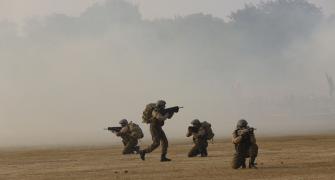'China did not expect India to show such strategic resolve in defending its territorial integrity.'

"There should be an easing of troops, but it should be mutual. The process includes disengagement, de-escalation and de-induction. We are still far away from de-induction," says Lieutenant General Vinod Bhatia, PVSM, AVSM, SM (retd) and former director general of military operations.
"It is a slow, meticulous process which needs verification and re-verification. We will be looking at a long haul", the general adds.
An officer from the Parachute Regiment, India's special forces, the general served the Indian Army for four decades and held command assignments on both the Pakistan and China borders.
In an interview with Rediff.com's Archana Masih, General Bhatia says while it is good that India and China have reached an agreement about Eastern Ladakh, we need to know the modalities, keep our vigil and not blink!
Have you been able to analyse the announcements that have been made by India and China about the border agreement in the Depsang Plains and Demchok?
It is a win-win situation for both because if you look at the bigger picture and geopolitics, China needs India more than India needs China.
The reasons are:
1. China is looking at a bipolar world. In order to achieve this in view of the fierce competition between the US and China, it will need India, which is a risen power and is now a global leader.
China does not want an anti-China India.
2. China has realised that it has opened up too many fronts -- Taiwan, Japan, South Korea, South China Sea, India. Five of the major flash points of conflict in the world are connected to China.
3. China did not expect India to show such strategic resolve in defending its territorial integrity. They went wrong in their calculations and needed to save face. This gives them a face-saving exit.

Can China be trusted considering there is such a deep lack of trust between the two countries?
We should not trust China. We know what happened in May 2020 in Galwan which I refer to as Hindi-Chini Bhai-Bhai 2.2.
We should be watchful that there is no 3.2.
Therefore, we should continue to invest in infrastructure development, capability building and capacity enhancement so that we speak to China from a position of relative strength.
China respects strength and we have to demonstrate strength to China.
China is known to read and interpret agreements in their own way. They have no love lost for rules.
We should not be complacent about the terms of any agreement because China has mercilessly violated five agreements which had stood the test of time for three-and-a-half decades.
The bottom line is that while it is good that India and China reached an agreement about Eastern Ladakh, we need to know the modalities and read the fine print.
Will the PLA withdraw from Depsang Plains and Demchok and will the Indian Army be able to patrol area it used to like before?
I am not too sure because the modalities are being worked out. The LAC (Line of Actual Control, the border separating India and China) is not defined and there's no common understanding about our perception of the LAC and theirs.
The two sides will work on the points each side will patrol, the frequency and timing of the patrols etc.
As I see it, it will give access to the patrolling points they had blocked. They had occupied and blocked us from the Raki Nala bottleneck which provides main access to the Depsang Plains.
If they vacate Raki Nala it will give us access to our patrol points 10, 11, 12, 13, 14, 15, and I see that happening.

How long would it take for protocols, verification and measures for patrolling to be mutually agreed and carried on the ground?
The process could take some time, but in this case, time is not important. We've been engaged in a stand-off for four-and-a-half years and we will come to a mutual understanding.
The periodicity, frequency, strength of the patrol and patrolling limits will be worked out by mutual consent, but we should be careful.
We should maintain our vigil and intelligence surveillance reconnaissance. We should have the wherewithal to monitor their movements.
Will this lead to a status quo ante pre-2020?
I don't believe so because China's strategy is to claim, occupy, legitimise, exploit, integrate. They have already claimed it since September 1959 and will not give up the claim so easily to maintain the same peace and tranquility as it prevailed prior to May 2020.
We will have to position troops even after the disengagement. We'll have to position reserves for contingencies because there is a trust deficit.
Will there now be some withdrawal of PLA troops from forward positions?
I see that happening basically at the two remaining places. They will withdraw to a certain position, but they would like to dominate the areas where they had come because they already have the infrastructure in place.

Will the Indian Army continue to reinforce the LAC as it has, or we will be seeing some easing of troops?
Definitely. In time, we will have reserves and contingency plans. There should be an easing of troops, but it should be mutual.
The process includes disengagement, de-escalation and de-induction. We are still far away from de-induction.
It is a slow, meticulous process which needs verification and re-verification. We will be looking at a long haul.
Considering the difficult and complicated relationship between India and China, despite this agreement, there is plenty to be cautious about because anything can cause another pause, right?
Absolutely! Even a small incident can change everything. We have to maintain a vigil, no blinking and no brinkmanship.
Four-and-a-half years later, what did China hope to gain? What was their purpose behind taking military action in Galwan?
To contain India. They have diverted our resources and our attention -- Pakistan, Bangladesh, Sri Lanka, Maldives, Nepal, Tibet and China is in border resolution talks with Bhutan.

What are some of the top most concerns that we must be cautious about while dealing with China?
We have to keep talking to the Chinese and continue to build our capabilities, infrastructure capacities to defend the LAC and dominate the sea lines of communication.
Thirdly, use diplomacy to engage with like-minded nations and leverage Quad and other multilaterals.
Feature Presentation: Aslam Hunani/Rediff.com








